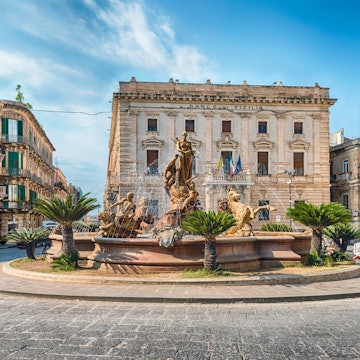

Vieste in Puglia, Italy. leonori/Shutterstock
Puglia exemplifies everything that is seductive about Southern Italy. Its dramatic beaches are lapped by two luridly turquoise seas. The light-dappled woods of the Promontorio del Gargano shift to rolling countryside blanketed in almond and olive groves. In snug whitewashed villages, lazy lunches are washed down with prized regional vino and capped off with local pastries.
Should you choose to road-trip between bougainvillea-draped towns in the Valle d’Itria or snorkel in the Isole Tremiti (Tremiti Islands), Puglia's diverse landscapes deliver along the full length of this 432km (268 mile) region. And the list of great things to do is just as long. These highlights are bound to have you plotting your own Puglian sojourn.
1. Island-hop the Tremiti archipelago
You’re guaranteed a much better time on the Isole Tremiti than poor Julia the Younger, who was exiled here by her uncle, better known as Emperor Augustus, on a charge of adultery in the 1st century CE. Located some 20km (12 miles) off the Promontorio del Gargano, the compact archipelago of five islands – San Domingo, San Nicola and the uninhabited Capraia, Crettaccio and Pianosa – is a pristine wonderland of snow-white bluffs, Aleppo pines and crystalline waters littered with starfish, lobsters and rare black coral. Stay on verdant San Domingo or time-warped San Nicola; the latter’s medieval abbey is worth a visit for its 11th-century floor mosaics. Boating and diving tours from San Domingo reach tiny Capraia, its limpid inlets perfect for snorkeling.
Planning tip: The best time for beach weather without the crowds is June or September. Ferries to San Domingo sail from Vieste, Manfredonia and Peschici in summer and from Termoli year-round. Most tourist facilities on the islands are closed in winter.
2. Hike the Parco Nazionale del Gargano
If northern Puglia’s Promontorio del Gargano reminds you of the Dalmatian coast, it’s no coincidence. Millions of years ago, the spur of the Italian boot was connected to what is now Croatia. Today, one of Italy’s most beautiful national parks, the Parco Nazionale del Gargano, constitutes much of this mountainous nugget.
Covering 1181 sq km (456 sq miles), the park is traversed by well-marked hiking paths, from short and breezy to calf toning and sweaty. Lace up your boots and hit one of the trails inside the silent Foresta Umbra (Forest of Shadows), an ancient woodland harboring roe deer, wild boar, elusive wild cats and over 65 varieties of orchids. For lofty coastal panoramas, the tract between Vignanotica and Mergoli is a moderately difficult walk on Gargano’s lush, precipitous coastline.
Planning tip: Not only is Vieste one of Puglia’s most atmospheric coastal towns, it’s an ideal base for exploring the park. Book accommodations well in advance in the summer.

3. Find your perfect Puglian beach
Chances are you’ve swooned over images of Cala Porto beach, framed by topaz seas, cliff-hugging abodes and an ancient bridge. Yet Polignano a Mare’s iconic cove is only one of many drop-dead gorgeous playgrounds on the Puglian coast.
In Mattinata, milky cliffs plunge down to white sand, meeting turquoise water with commanding rock formations at Baia delle Zagare, a staple on any list of Italy's best beaches. Further south in the Salento, a path leads through dense pine forest to Baia dei Turchi — its shallow, pellucid waters are a match for any Caribbean beach. On scorching days, cool down at rocky Cala dell’Acquaviva, where salt and spring waters mingle to invigorating effect. The latter beach is on Puglia’s Ionian coast, also home to Punta della Suina, a popular summertime hangout for LGBTIQ+ travelers partying in gorgeous, sun-bleached Gallipoli.
4. Feast like a local at a masseria in Ostuni
Do you laze by the pool in the shade of a fragrant orange tree, sample prized olive oils with an oil sommelier or master the art of pasta making? These are the tough choices you’re likely to face when staying at a masseria, the fortified farmhouses scattered across the Puglian countryside. Some are cheerfully rustic, others seriously chic; several are well known for their locavore restaurants and cooking classes.
One epicurean favorite is Masseria Il Frantoio in Ostuni. The 500-year-old olive farm is famous for its superb oils. Savor them at an olive oil degustation or, better still, one of the multicourse feasts. Sophisticated takes on Puglia’s cucina povera (peasant cuisine) are on the menu at Fasano’s luxe Masseria Torre Coccaro, where the cooking school will have you hand rolling orecchiette pasta like a Puglian pro.
5. Celebrate coastal heritage on trabucchi on the Adriatic
Travel the Puglian coastline between Peschici and Vieste and you’ll spot giant, Tim Burton–esque structures jutting out of the sea. These stilted creatures are trabucchi, historic fishing machines used to lower nets into the water using a complex system of winches.
Abandoned for many years, trabucchi are enjoying a renaissance as nonprofit associations, such as Vieste-based La Rinascita dei Trabucchi Storici, lovingly restore these cultural icons of the lower Adriatic. The association runs activities throughout the year, from traditional fishing experiences to other events. Some trabucchi have been converted into restaurants serving the freshest local seafood. One standout is Al Trabucco, located just past Peschici.

6. Cycle the trulli-scattered Valle d’Itria from Putignano
Instigator of endless tree-change fantasies, the Valle d’Itria stretches from Putignano to Ostuni in a sweep of undulating vineyards, olive trees and hobbit-esque trulli (limestone huts with conical roofs). Trulli are unique to Puglia, and you’ll find the greatest concentration of them in Alberobello.
While the town’s storybook streets merit exploration, dig deeper by renting a bicycle or e-bike and exploring the valley's back roads. These will lead you from the mysterious rock church of Santa Maria di Barsento to wineries like I Pàstini. The Ciclovia di Acquedotto Pugliese, a scenic cycling trail, follows the route of an aqueduct that stretches from Campania to Puglia’s southern tip.
Planning tip: Numerous operators in the Valle d’Itria offer e-bike rental and guided cycling tours. Among them is the highly recommended Ebike Puglia.
7. Fall under the spell of the pizzica in Salento
It’s said that Puglia’s pizzica was conceived with the intent of healing “hysterical” and “obscene” women who were under the malevolent spell of tarantula spiders. Centuries later, the folk dance remains a hypnotic spectacle, its frenzied, rhythmic motions both beautiful and liberating.
The best place to become enchanted is in Puglia’s Salento. Not only is the peninsula the pizzica’s spiritual home, it’s the setting for August’s Notte della Taranta, a festival that celebrates the dances of the region. Events take place in numerous towns, with an epic finale in Melpignano. The town is located in Grecìa Salentina (Salentine Greece), an area famous for its Greek dialect. Of course, there’s no need to wait until August to hone your moves; dance teachers run classes throughout the year, among them Lecce’s highly regarded Serena D’Amato.

8. Binge on baroque in Lecce
When it comes to architectural exuberance, the university city of Lecce takes the torta (cake). Its baroque architects went all-in, turning the city’s malleable limestone into outrageously flamboyant buildings that earned their own moniker: barocco leccese (Lecce baroque). Jaws free-fall at the Basilica di Santa Croce, whose facade explodes with allegorical griffins, wolves, lions, flowers, fruits and vegetables. Telamons – huge male figures used as columns – in Turkish dress groan under the weight of a balustraded balcony, itself in the shadow of a magnificent rose window.
The basilica’s facade was designed in part by 17th-century Leccese starchitect Giuseppe Zimbalo, whose legacy also includes the reconstruction of the city’s commanding cathedral. The latter looms large over the cinematic Piazza del Duomo, itself a baroque show-off that glows ethereally at the golden hour.
Local tip: Lecce is renowned for its pasticciotto, a short-crust pastry filled with luscious crema pasticcera (Italian pastry cream). You’ll find one of the best at Caffè Alvino, a short walk from both the basilica and cathedral.
















